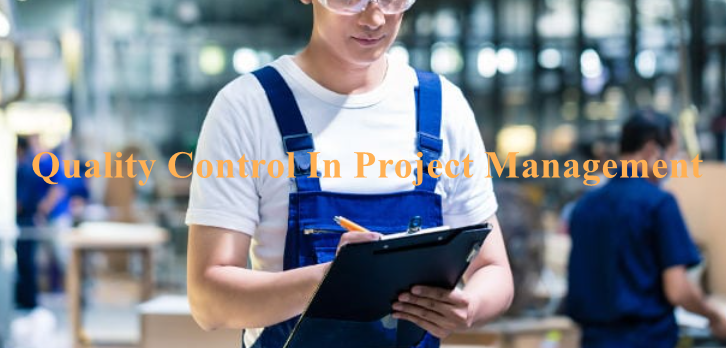It is the quality control of the construction organization and construction site that is the most important aspect of project management. Aspects of process and product quality assurance are both part of the scope of the control measures in place. People, materials, machinery, methods, and the environment all play a role in quality control. As a result, maintaining strict quality control over these 5 variables is essential to ensuring the success of the project.

5 Elements Of Quality Control In Project Management
1. Related to the behavior of individuals
There are many factors that affect human performance, such as the quality of the leaders and the level of knowledge and skill of the operators. Human factors in construction must be taken into account first and foremost because people constitute the bulk of the construction effort. All the engineers, operators, and support staff involved in the project’s construction have an impact on the quality of the final product. The quality of a project is largely determined by these factors. To begin, they must raise their level of quality consciousness. In order to begin construction, workers must establish five concepts: quality first, pre-control first, serving users, speaking with data, and comprehensive benefits for social good and business good (the combination of quality, cost and construction period). The second factor is the quality of the workforce. Quality of management and technical staff. High project quality can only be achieved if the project management system is flawless and effective technical measures are in place; if these measures are in place, the project quality will be high. To indirectly secure the quality of the project, the service people must provide technical and living services with exceptional job quality that are backed by the legal idea of properly applying quality standards and operating procedures. Quality education, spiritual and monetary rewards, and on-the-job technical training via training and optimization may be used to increase people’s quality.
2. Material
Building a project necessitates a wide range of materials (including raw materials, completed goods, semi-finished goods, components, and fittings). A project’s quality can only be ensured by its materials. The project’s quality will be compromised if the materials are of poor quality. As a result, improving the project’s quality through tightening up quality control on the materials is critical. Material composition, physical qualities, chemical properties, and so on are the most important aspects in determining the quality of a product. Among the most important aspects of quality control are:
-The first step is to pick buying employees, develop their political and quality evaluation abilities, and select those with specific professional skills. In order to get the task done, you’ll need someone who has your back.
-Selecting vendors and learning about their products is the second step.
-Organize the supply of materials in a reasonable manner to ensure proper construction.
-Enhance material acceptance and inspection processes and maintain tight quality controls.
-Consider how materials are being managed on site and be efficient in your use.
-Do well in the testing and inspection of materials
It’s estimated that 70% to 80% of a building project’s overall spending is spent on materials. As a result, the project is awarded to certain contractors. When it comes to maximizing profits, the company does not purchase finished or semi-finished products in accordance with engineering specifications or effectively control the quality of its raw materials due to low purchasing personnel standards, and is laissez-faire to collect kickbacks or benefit fees. Many other companies lack the proper management and restraining mechanisms to prevent unqualified fake and inferior items from entering the building of a project, allowing quality concealed hazards to the project to remain undetected. In today’s technologically advanced world, a scientific approach for inspecting materials is available.
3. Party factors:
In the building process, techniques include the technical scheme, process flow, organizational measures, detection methods, and the design of the construction organization, among others. The seamless execution of project quality control is directly impacted by the correctness or incorrectness of the construction plan. Due to a lack of consideration of the construction plan, the quality of the project is affected and the investment is increased. This means that the construction plan must be thoroughly analyzed and evaluated from a wide range of perspectives, including technology, management, process, organization, operation and economy in order to ensure that the plan is technically feasible, economically reasonable and technologically advanced with effective measures, which is conducive to the project’s success.
4. Equipment of this type includes
There are many factors that must be taken into account during construction in order to make an informed decision about the sort of machinery and energy parameters that may be fairly used and run correctly. Construction machinery operators must adhere to a number of laws and regulations, as well as enhance their skills in the areas of repair, maintenance, and management.
5. There are environmental aspects to consider.
One of the most important things to consider when designing any project is how it will be affected by the surrounding environment. Ambient conditions have a wide ranging and constantly shifting effect on the quality of construction projects. Temperature, humidity, high wind, precipitation, severe heat and cold all have a direct impact on the project quality, for example. As a rule, the prior process and the preceding sub item and divisional project are often the environment for the following process. Because of this, the project’s special circumstances necessitate that appropriate and effective environmental quality control procedures be performed.
Seasonal measures to protect project quality during construction, such as concrete works in the winter rainy and hot seasons, underwater works and high-altitude operations, must also be devised based on the project’s characteristics. This will ensure that the quality of the project is not damaged by freezing, cracking, washing, etc. Additionally, it is required to consistently improve the construction site’s environment, reduce environmental pollution as a result of construction-related dangers, enhance the site’s management system, and apply civilized construction.